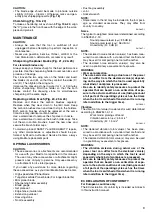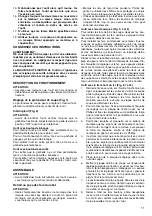
8
For the correct planer blade setting
Your planing surface will end up rough and uneven, unless the blade is set properly and securely. The blade must be
mounted so that the cutting edge is absolutely level, that is, parallel to the surface of the rear base.
Refer to some examples below for proper and improper settings.
Connecting a vacuum cleaner (Fig. 9)
For tool without nozzle
When you wish to perform clean planing operation, con-
nect a Makita vacuum cleaner to your tool. Before con-
necting the vacuum cleaner, remove the chip cover from
the tool. Then connect a hose of the vacuum cleaner to
the nozzle (optional accessory) as shown in the figures.
For tool with nozzle
When you wish to perform clean planing operation, con-
nect a Makita vacuum cleaner to your tool. Then connect
a hose of the vacuum cleaner to the nozzle as shown in
the figures.
Nozzle assembly (optional accessory)
Use of the special nozzle assembly will minimize chip
scatter, making for a cleaner work area.
(Fig. 10)
The nozzle assembly may be attached after the chip
cover on the machine body is removed. When slipping on
the assembly, fit the pin on it into the rear cover hole. Use
the chip cover screws to fasten it in place.
(Fig. 11)
Nozzle cleaning
Clean the nozzle regularly.
Use a compressed air to clean the clogged nozzle.
OPERATION
WARNING:
• To reduce the risk of injury to persons, do not oper-
ate without nozzle or chip cover in place.
Planing operation (Fig. 12)
First, rest the tool front base flat upon the workpiece sur-
face without the blades making any contact. Switch on
and wait until the blades attain full speed. Then move the
tool gently forward. Apply pressure on the front of tool at
the start of planing, and at the back at the end of planing.
Planing will be easier if you incline the workpiece in sta-
tionary fashion, so that you can plane somewhat downhill.
The speed and depth of cut determine the kind of finish.
The power planer keeps cutting at a speed that will not
result in jamming by chips. For rough cutting, the depth of
cut can be increased, while for a good finish you should
reduce the depth of cut and advance the tool more
slowly.
Shiplapping (Rabbeting) (Fig. 13, 14, 15, 16 & 17)
To make a stepped cut as shown in
Fig. 13
, use the edge
fence (guide rule).
Draw a cutting line on the workpiece. Insert the edge
fence into the hole in the front of the tool. Align the blade
edge with the cutting line.
(Fig. 14)
Adjust the edge fence until it comes in contact with the
side of the workpiece, then secure it by tightening the
screw.
(Fig. 15)
When planing, move the tool with the edge fence flush
with the side of the workpiece. Otherwise uneven planing
may result.
Max. shiplapping (Rabbeting) depth is 23 mm.
You may wish to add to the length of the fence by attach-
ing an extra piece of wood. Convenient holes are pro-
vided in the fence for this purpose, and also for attaching
an extension guide (optional accessory).
(Fig. 16
& 17
)
(A)
(B)
(B)
(A)
(B)
(A)
(A) Front base (Movable shoe)
(B) Rear base (Stationary shoe)
Correct setting
Nicks in surface
Gouging at start
Gouging at end
Although this side view cannot show it,
the edges of the blades run perfectly
parallel to the rear base surface.
Cause: One or both blades fails to
have edge parallel to rear
base line.
Cause: One or both blade edges fails
to protrude enough in relation
to rear base line.
Cause: One or both blade edges
protrudes too far in relation to
rear base line.
Содержание N1923B
Страница 5: ...5 25 26 44 43 42 43 004903 004905 ...
Страница 61: ...61 ...
Страница 62: ...62 ...
Страница 63: ...63 ...









































